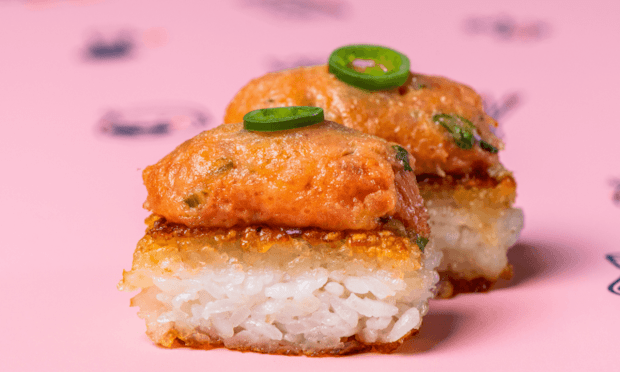Krispy Rice Ghost Kitchens Build Following With Joy-Centric Messaging

The ghost kitchen space has grown enormously since the start of the pandemic, as restaurants’ physical locations became far less important to contagion-conscious consumers than their ability to fulfill off-premises orders safely and competently. In January of 2020, most people had not even heard of ghost kitchens. In the last 14 months, however, these virtual brands have become increasingly widespread — a quick Google Trends search shows a gradual rise since the start of the pandemic, indicating that consumers are growing curious about this innovative model.
Hospitality company SBE Entertainment Group’s restaurant and ghost kitchen group C3 (which stands for Creating Culinary Communities) has taken advantage of this trend to develop its suite of restaurant brands and build their followings. Sushi brand Krispy Rice, for one, hit the ground running, building on the success of SBE’s Katsuya brand. The brand quickly garnered a loyal customer base and a strong social media following. By the time of the restaurant’s one-year anniversary last month, it already had 40 locations, with 50 more in the works.
“Krispy Rice is an off-shoot of the popular Katsuya restaurants, which help launch the brand with an existing fan base and a product that was made extremely well,” Vincenzo Rossy, senior director of openings for C3, told PYMNTS in an interview. “However, we attribute the ‘near-instant’ success to the fact that Krispy Rice helped bring the fun of dining into people’s homes during a year when delivery became the new norm and in-home experiences needed to stand out. We were proud to see all of the Instagram posts and shares from people’s Krispy Rice orders, which helped the brand grow a viral and loyal following.”
Giving Consumers Something To Get Excited About
This strong visual appeal, which has made Krispy Rice’s menu items highly sharable for social media users, has been hugely important. As Rossy reflected, “Social media has been instrumental to the success of Krispy Rice.”
The Krispy Rice Instagram page has almost 40,000 followers, who tune in for shots of the brand’s cute, colorful packaging and its entertainment content, such as the Su-She Talks, which, Rossy explained, is “our monthly female empowerment series.” He noted that the brand has gone far beyond the boost it originally got from its tie to Katsuya. This connection “brought some of our earliest customers, but the brand’s explosive growth over the last year reached new heights because of word-of-mouth and social media buzz,” he said.
In addition to this social media appeal, the brand also attracts consumers by tailoring its menu items to their tastes and desires. To celebrate the anniversary, for instance, Krispy launched 12 new items, such as the Feelin’ Shellfish Box and the Spicy Tuna Krispy Roll, as well as an Anniversary Combo Box.
“When looking at menu items and considering additions, we take a look at what our menu mix looks like, what our competitors are doing, and what our consumers would like and potentially clamoring for,” said Rossi.
Owning The Transaction
The third-party restaurant aggregator model is notoriously difficult for restaurants, and consumers are growing frustrated with the steep fees these delivery services leverage. Additionally, third-party delivery services mediate the transaction with the consumer, controlling the messaging and owning users’ data, which leaves the restaurant at a disadvantage. C3 recently launched its own delivery app for its restaurant brands, CITIZENS GO, to enable them to avoid relying on these aggregators.
“By launching our own proprietary delivery app, C3 is able to break the food industry’s dependence on third-party platforms,” said Rossi. “CITIZENS GO eliminates hidden delivery fees and gives consumers the power to group menu items from multiple restaurants into a single cart.”
This delivery app will be just one part of C3’s strategy going forward. The company also takes an innovative approach to physical spaces, setting up restaurants at sites that are key to consumers’ daily routines and giving a face to its online offerings.
“As delivery stabilizes and consumers return to a post-pandemic lifestyle, C3 believes diners will return to in-person dining, but delivery is not going away,” said Rossi. “C3’s omnichannel business model allows multiple ways for consumers to experience and enjoy our award-winning culinary brands like Krispy Rice through delivery … or at one of our physical locations around the U.S., including existing storefronts or locations inside hotels, residential communities and soon shopping malls, food halls and airports.”
Krispy Rice Goes Brick-And-Mortar
One of these physical restaurants will be a consumer-facing Krispy Rice location in New York, which will open in the coming months.
“The first physical Krispy Rice location is set to debut in New York’s Manhattan West development summer 2021,” said Rossi. “Our customers get a different type of experience and brand connection at these four-wall locations … brick-and-mortar locations are a natural continuation of these brands, and a way to diversify the real estate developments C3 will continue investing in.”
This Midtown location will situate Krispy Rice near Hudson Yards, giving it access to the corporate lunch crowd as newly vaccinated workers return to the office, as well as to the area’s rush of tourists from across the U.S. and around the world.
“Since Krispy Rice first launched as a delivery-only concept, we’re excited for customers to build a stronger connection with the brand in person at physical locations later this year,” said Rossi. “…Ultimately, our goal is to be fun, innovative, and inspiring…We want to provide the masses with delicious food … that creates an emotional connection with our guests.
